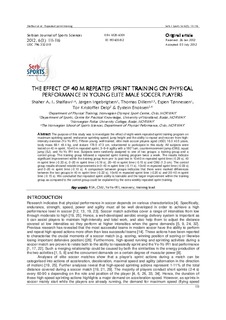| dc.contributor.author | Shalfawi, Shaher A.I. | |
| dc.contributor.author | Ingebrigtsen, Jørgen | |
| dc.contributor.author | Dillern, Thomas | |
| dc.contributor.author | Tønnessen, Espen | |
| dc.contributor.author | Delp, Tor Kristoffer | |
| dc.contributor.author | Enoksen, Eystein | |
| dc.date.accessioned | 2015-07-02T12:30:41Z | |
| dc.date.accessioned | 2015-07-06T08:40:32Z | |
| dc.date.available | 2015-07-02T12:30:41Z | |
| dc.date.available | 2015-07-06T08:40:32Z | |
| dc.date.issued | 2012 | |
| dc.identifier.citation | Shalfawi, S. A. I., Ingebrigtsen, J., Dillern, T., Tønnessen, E., Delp, T. K. & Enoksen, E. (2012). The effect of 40 m repeated sprint training on physical performance in young elite male soccer players. Serbian Journal of Sports Sciences, 6(3), 111-116. Retrieved from https://sjss.sportsacademy.edu.rs/archive/details/the-effect-of-40-m-repeated-sprint-training-on-physical-performance-in-young-elite-male-soccer-players-393.html | nb_NO |
| dc.identifier.issn | 1452-8827 | |
| dc.identifier.uri | http://hdl.handle.net/11250/286532 | |
| dc.description.abstract | The purpose of this study was to investigate the effect of eight-week repeated sprint training program on maximum sprinting speed, endurance sprinting speed, jump height and the ability to repeat and recover from high-intensity exercise (Yo-Yo IR1). Fifteen young, well-trained, elite male soccer players aged (±SD) 16.3 ±0.5 years, body mass 68.1 ±9.4 kg, and stature 178.5 ±7.3 cm, volunteered to participate in this study. All subjects were tested on 40 m sprint, 10x40 m repeated sprint, 3–6–9 agility with a 180° turn, countermovement jump (CMJ), squat jump (SJ), and Yo-Yo IR1 test. Subjects were randomly assigned to one of two groups: a training group and a control group. The training group followed a repeated sprint training program twice a week. The results indicate significant improvement within the training group from pre- to post-test in 10x40 m repeated sprint time (-0.29 s), 40 m sprint time (-0.33 s), 0–20 m sprint time (-0.19 s), 20–40 m sprint time (-0.15 s) and CMJ (1.3 cm). The control group results showed notable improvements in 0–40 m sprint time (-0.11 s), 10x40 m repeated sprint time (-0.09 s) and 0–20 m sprint time (-0.10 s). A comparison between groups indicates that there were marked differences between the two groups in 40 m sprint time (-0.22 s), 10x40 m repeated sprint time (-0.20 s) and 20–40 m sprint time (-0.15 s). We concluded that repeated sprint ability is trainable and the larger improvement within the training group as compared to the control group could be explained by the extra weekly repeated sprint training. | nb_NO |
| dc.language.iso | eng | nb_NO |
| dc.publisher | Sports Academy, Belgrade | nb_NO |
| dc.title | The effect of 40 m repeated sprint training on physical performance in young elite male soccer players | nb_NO |
| dc.type | Journal article | nb_NO |
| dc.type | Peer reviewed | nb_NO |
| dc.date.updated | 2015-07-02T12:30:41Z | |
| dc.subject.nsi | VDP::Social science: 200::Social science in sports: 330 | nb_NO |
| dc.source.pagenumber | 111-116 | nb_NO |
| dc.source.volume | 6 | nb_NO |
| dc.source.journal | Serbian Journal of Sports Sciences | nb_NO |
| dc.source.issue | 3 | nb_NO |
| dc.identifier.cristin | 932645 | |
